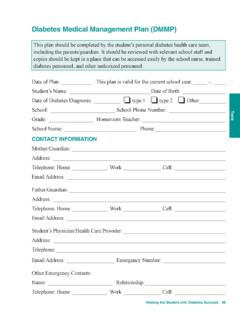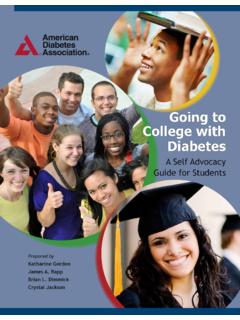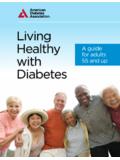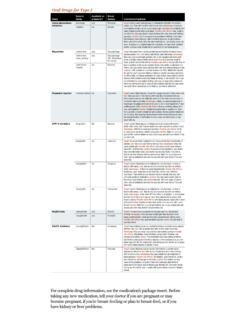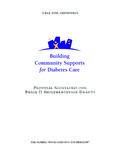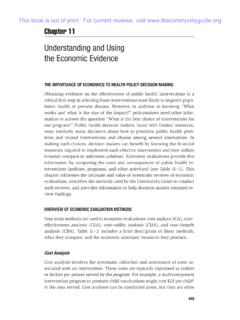Transcription of Diabetes Medical Management Plan (DMMP)
1 Tools for Effective Diabetes Management | 61 Diabetes Medical Management Plan (DMMP)This plan should be completed by the student s personal Diabetes health care team, including the parents/guardians. It should be reviewed with relevant school staff and copies should be kept in a place that can be accessed easily by the school nurse, trained Diabetes personnel, and other authorized 1 of 7, DMMPDate of plan: _____ This plan is valid for the current school year: _____ _____Student informationStudent s name: _____ Date of birth: _____Date of Diabetes diagnosis: _____ Type 1 Type 2 Other: _____School: _____ School phone number: _____Grade: _____ Homeroom teacher: _____School nurse: _____ Phone: _____Contact informationParent/guardian 1: _____Address: _____Telephone: Home.
2 _____ Work: _____ Cell: _____Email address: _____Parent/guardian 2: _____Address: _____Telephone: Home: _____ Work: _____ Cell: _____Email address: _____Student s physician/health care provider: _____Address: _____Telephone: _____ Emergency number: _____Email address: _____Other emergency contacts:Name: _____ Relationship: _____Telephone: Home: _____ Work: _____ Cell: _____Page 1 of 7, DMMPT ools for Effective Diabetes Management | 62 Checking blood glucoseBrand/model of blood glucose meter: _____Target range of blood glucose: Before meals: 90 130 mg/dL Other: _____ Check blood glucose level: Before breakfast After breakfast ____ Hours after breakfast 2 hours after a correction dose Before lunch After lunch ____ Hours after lunch Before dismissal Mid-morning Before PE After PE Other: _____ As needed for signs/symptoms of low or high blood glucose As needed for signs/symptoms of illness Preferred site of testing: Side of fingertip Other: _____Note.
3 The side of the fingertip should always be used to check blood glucose level if hypoglycemia is s self-care blood glucose checking skills: Independently checks own blood glucose May check blood glucose with supervision Requires a school nurse or trained Diabetes personnel to check blood glucose Uses a smartphone or other monitoring technology to track blood glucose values Continuous glucose monitor (CGM): Yes No Brand/model: _____Alarms set for: Severe Low: _____ Low: _____ High: _____Predictive alarm: Low: _____ High: _____ Rate of change: Low: _____ High: _____Threshold suspend setting: _____Additional information for student with CGM Confirm CGM results with a blood glucose meter check before taking action on the sensor blood glucose level.
4 If the student has signs or symptoms of hypoglycemia, check fingertip blood glucose level regardless of the CGM. Insulin injections should be given at least three inches away from the CGM insertion site. Do not disconnect from the CGM for sports activities. If the adhesive is peeling, reinforce it with approved Medical tape. If the CGM becomes dislodged, return everything to the parents/guardians. Do not throw any part away. Refer to the manufacturer s instructions on how to use the student s s Self-care CGM SkillsIndependent?The student troubleshoots alarms and malfunctions. Yes NoThe student knows what to do and is able to deal with a HIGH alarm.
5 Yes NoThe student knows what to do and is able to deal with a LOW alarm. Yes NoThe student can calibrate the CGM. Yes NoThe student knows what to do when the CGM indicates a rapid trending rise or fall in the blood glucose level. Yes NoThe student should be escorted to the nurse if the CGM alarm goes off: Yes No Other instructions for the school health team: _____Page 2 of 7, DMMPT ools for Effective Diabetes Management | 63 Hypoglycemia treatmentStudent s usual symptoms of hypoglycemia (list below): _____If exhibiting symptoms of hypoglycemia, OR if blood glucose level is less than _____ mg/dL, give a quick-acting glucose product equal to _____ grams of carbohydrate.
6 Recheck blood glucose in 15 minutes and repeat treatment if blood glucose level is less than _____ treatment: _____If the student is unable to eat or drink, is unconscious or unresponsive, or is having seizure activity or convulsions (jerking movement): Position the student on his or her side to prevent choking. Give glucagon: 1 mg mg Other (dose) _____ Route: Subcutaneous (SC) Intramuscular (IM) Site for glucagon injection: Buttocks Arm Thigh Other: _____ Call 911 (Emergency Medical Services) and the student s parents/guardians. Contact the student s health care treatmentStudent s usual symptoms of hyperglycemia (list below): _____ Check Urine Blood for ketones every ____ hours when blood glucose levels are above _____ mg/dL.
7 For blood glucose greater than _____ mg/dL AND at least ____ hours since last insulin dose, give correction dose ofinsulin (see correction dose orders). Notify parents/guardians if blood glucose is over _____ mg/dL. For insulin pump users: see Additional Information for Student with Insulin Pump. Allow unrestricted access to the bathroom. Give extra water and/or non-sugar-containing drinks (not fruit juices): _____ ounces per treatment for ketones: _____ Follow physical activity and sports orders. (See Physical Activity and Sports)If the student has symptoms of a hyperglycemia emergency, call 911 (Emergency Medical Services) and contact the student s parents/guardians and health care provider.
8 Symptoms of a hyperglycemia emergency include: dry mouth, extreme thirst, nausea and vomiting, severe abdominal pain, heavy breathing or shortness of breath, chest pain, increasing sleepiness or lethargy, or depressed level of therapyInsulin delivery device: Syringe Insulin pen Insulin pump Type of insulin therapy at school: Adjustable (basal-bolus) insulin Fixed insulin therapy No insulinPage 3 of 7, DMMPT ools for Effective Diabetes Management | 64 Page 4 of 7, DMMPI nsulin therapy (continued)Adjustable (Basal-bolus) Insulin Therapy Carbohydrate Coverage/Correction Dose: Name of insulin: _____ Carbohydrate Coverage:Insulin-to-carbohydrate ratio:Lunch: 1 unit of insulin per _____ grams of carbohydrate Breakfast: 1 unit of insulin per _____ grams of carbohydrateSnack: 1 unit of insulin per _____ grams of carbohydrateCarbohydrate Dose Calculation ExampleTotal Grams of Carbohydrate to Be Eaten Insulin-to-Carbohydrate Ratio= ____ Units of InsulinCorrection dose.
9 Blood glucose correction factor (insulin sensitivity factor) = _____ Target blood glucose = _____ mg/dL Correction Dose Calculation Example= ____ Units of InsulinCurrent Blood Glucose Target Blood GlucoseCorrection FactorCorrection dose scale (use instead of calculation above to determine insulin correction dose): Blood glucose _____ to _____ mg/dL, give _____ units Blood glucose _____ to _____ mg/dL, give _____ unitsBlood glucose _____ to _____ mg/dL, give _____ units Blood glucose _____ to _____ mg/dL, give _____ unitsSee the worksheet examples in Advanced Insulin Management : Using Insulin-to-Carb Ratios and Correction Factors for instructions on how to compute the insulin dose using a student s insulin-to-carb ratio and insulin correction to give insulin:Breakfast Carbohydrate coverage only Carbohydrate coverage plus correction dose when blood glucose is greater than _____ mg/dL and ____ hours since last insulin dose.
10 Other: _____Lunch Carbohydrate coverage only Carbohydrate coverage plus correction dose when blood glucose is greater than _____ mg/dL and ____ hours since last insulin dose. Other: _____Snack No coverage for snack Carbohydrate coverage only Carbohydrate coverage plus correction dose when blood glucose is greater than _____ mg/dL and ____ hours since last insulin dose. Correction dose only: For blood glucose greater than _____ mg/dL AND at least ____ hours since last insulin dose. Other: _____Tools for Effective Diabetes Management | 65 Insulin therapy (continued)Fixed Insulin Therapy Name of insulin: _____ _____ Units of insulin given pre-breakfast daily _____ Units of insulin given pre-lunch daily _____ Units of insulin given pre-snack daily Other: _____Parents/Guardians Authorization to Adjust Insulin Dose Yes No Parents/guardians authorization should be obtained before administering a correction dose.
